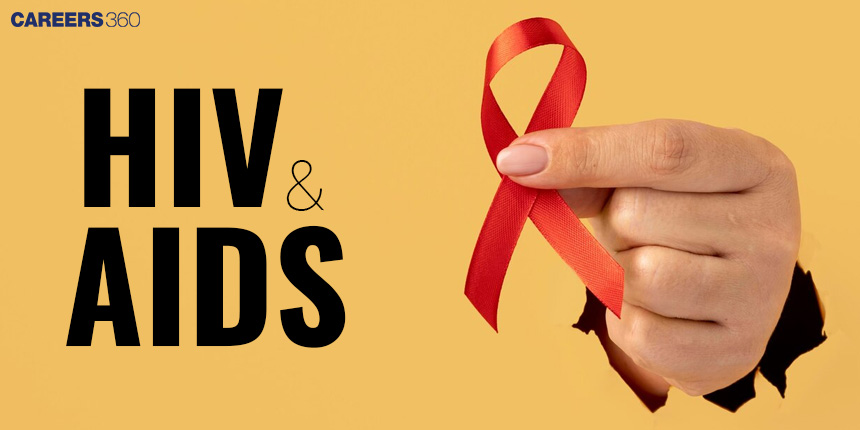Difference Between HIV and AIDS: Definition, Types, Examples, Symptoms
HIV (Human Immunodeficiency Virus) and AIDS (Acquired Immunodeficiency Syndrome) are closely related but different conditions. HIV is a virus that attacks the immune system, specifically targeting CD4 cells, which help fight infections. If left untreated, HIV can progress to AIDS, the final stage of the infection. This topic is included in the class 12 chapter Human Health and Disease in the subject of Biology. This topic is relevant for exams like NEET and AIIMS BSc Nursing, where questions about HIV/AIDS are asked.
NEET 2025: Mock Test Series | Syllabus | High Scoring Topics | PYQs
NEET Important PYQ's Subject wise: Physics | Chemistry | Biology
New: Meet Careers360 B.Tech/NEET Experts in your City | Book your Seat now
- HIV and AIDS
- What is HIV?
- What is AIDS?
- Difference Between HIV and AIDS
- Recommended Video on the Difference Between HIV and AIDS

HIV and AIDS
Although many people use the terms interchangeably, HIV and AIDS are not the same thing. HIV stands for the human immunodeficiency virus, which attacks the human body's immune system, while AIDS stands for Acquired Immunodeficiency Syndrome, meaning a state that develops in people who have gone without treatment for HIV. Successful prevention, diagnosis, and treatment depend on a clear distinction between HIV and AIDS.
Also Read:
What is HIV?
HIV is a virus that breaks down the immune system, the CD4 cells, also called T cells play a role in protecting the body from infections. HIV gradually destroys the immune system and thus exposes it to infections and diseases. Left untreated, HIV develops into AIDS, which is termed the last stage of an infection, here, the immune system is completely destroyed. HIV is primarily transmitted through blood, sexual contact, and from mother to child at birth or through breastfeeding.
What is AIDS?
AIDS (Acquired Immunodeficiency Syndrome) is the final stage of HIV infection. This usually occurs when a person's immune system has been seriously impaired, leaving their body so open to infections and other cancers. The distressing diseases found in people with AIDS can be fatal due to lost immune function. AIDS can be fatal if not treated. If one is living with HIV, antiretroviral therapy or ART can mitigate it by preventing HIV from turning into AIDS.
Difference Between HIV and AIDS
The major differences between HIV and AIDS are given below:
Feature | HIV | AIDS |
Full Form | Human Immunodeficiency Virus | Acquired Immunodeficiency Syndrome |
| Definition | A virus that attacks the immune system, specifically CD4 cells. | The final, most severe stage of HIV infection, is where the immune system is severely damaged. |
Cause | Caused by HIV virus | Caused by the progression of HIV |
| Effect on the body | Weakens the immune system over time. | This leads to severe immune system damage, making the body vulnerable to infections and cancers. |
Stage | The early stage of infection | Advanced stage of HIV infection |
Symptoms | Mild or absent initially | Severe, including infections and cancers |
Diagnosis | Blood tests detecting HIV | Based on the presence of opportunistic infections |
Treatment | Antiretroviral therapy | Treatment for various opportunistic infections. |
HIV stands for Human Immunodeficiency Virus. It is a potential virus leading to infection, having an initial onset of the disease in which the symptoms might be very mild or even absent commonly diagnosed by blood tests that detect the presence of the virus. Treatment is based on antiretroviral therapy, which would help keep the infection under control from further progress.
The advanced stages, however, are actually what is referred to as AIDS—Acquired Immunodeficiency Syndrome. It manifests with very severe symptoms, such as opportunistic infections and cancers. In most cases, a diagnosis of ADS is made in the presence of particular infections or cancers that demand more intensive treatment to manage complications alongside continued ART. Progression from HIV to AIDS thus presents a deterioration in health conditions and immune function.
Also Read:
Recommended Video on the Difference Between HIV and AIDS
Frequently Asked Questions (FAQs)
HIV is a virus that causes AIDS. This syndrome results from the advanced stages of HIV infection.
Currently, there is no medication for the cure of HIV. It can, however, be contained with the aid of antiretroviral therapy.
If left untreated, HIV can progress to completely developed AIDS in about 10 years, though this again depends on the person.
Early symptoms can include fever, headache, and muscle aches, but some people may not show symptoms for years.
Prevention methods include using condoms, not sharing needles, getting tested regularly, and taking pre-exposure prophylaxis (PrEP) if at high risk.
Also Read
11 Jun'25 09:30 PM
09 Jun'25 01:11 PM
13 Nov'24 07:17 PM
13 Nov'24 05:08 PM
12 Nov'24 03:37 PM
12 Nov'24 01:07 PM
10 Nov'24 07:48 PM
08 Nov'24 04:15 PM
06 Nov'24 08:32 AM
